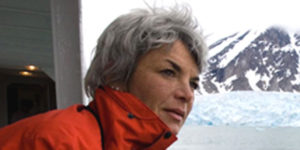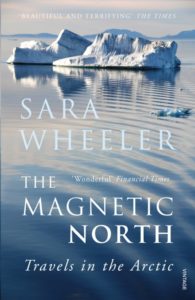Book Review – March 2022
Herds of reindeer move across ice and snow. Slim-shouldered Lapps squatting on skidoos nose their animals towards an arc of stockades. A man in a corral holds a pair of velvet antlers while another jabs a needle into a damp haunch. I make my way towards the outer palisades, where Lapps beyond working age stoke beechwood fires and gulp from bowls of reindeer broth, faces masked in musky steam. The first new snow has fallen, and the Harrå Sámi are herding reindeer down to the winter grazing.
Until the publication of The Magnetic North, Sara Wheeler was best known as a writer and explorer of the Antarctic. This book, however, takes her to the lands and seas of the other pole, the magnetic north of the title.
She commences her travels in the Russian far east, in the region of Chukotka. From here The Magnetic North circles the pole in a clockwise direction with sections on Alaska, the Canadian Arctic and Greenland. Crossing the Arctic Ocean, Wheeler visits Svalbard to the north of Norway, the Sámi lands of Scandinavia and the far north-west of Russia before ending her journey along the edge of the White Sea and European Russia’s Arctic coast.
In Chukotka, Wheeler stays with a Chukchi family, a people who are the ethnic brethren of the Inuit of Alaska, just across the surprisingly narrow Bering Strait. The traditional way of life of the Chukchi, nomadic and based on hunting and gathering, has been systematically destroyed by Moscow. First by Czarist expansionism and then by the forced collectivisation of the Soviet era when the Chukchi were compelled to live in towns. More recently the forces of state and private capital have turned their attention to the region’s mineral wealth.
Wheeler describes how this same story, of the way of life of indigenous peoples being squeezed out by incomers from the south, is played out in Alaska, Canada, Greenland and Scandinavia too. Traditional ways of sourcing food and earning a living through trade have been replaced by mind-numbing jobs and supermarkets full of fatty, processed foods. The kinship ties of Arctic communities have been broken down and replaced by an epidemic of obesity and drug and alcohol abuse.
But not all the news is bad. The Inuit peoples of Canada have managed to secure a degree of autonomy over at least some of their traditional lands, Greenland has enjoyed self-rule since 2009 and Wheeler notes that, in the Finnish north, many of the Sámi people still cling to their traditional ways. But the Arctic lands, even more so than the rest of the world, are facing an existential crisis resulting from anthropogenic climate change.
Since 1900, the mean global temperature has risen by 0.6°c. In the Arctic, the figure is 2-3°c.
Global warming, Wheeler reports, has reached a critical point for the Arctic. There is a broad scientific consensus that a rise in global temperature of 2°c or more above pre-industrial levels will bring about dangerous climate change effects. There is almost complete consensus on the cause of this rise in temperature too:
Almost all the data yields revealed some kind of correlation between anthropogenic emissions and temperature increase.
The Arctic lands and sea also suffer from the effects of industrial pollution, from emissions made elsewhere, often thousands of miles away. Because of the Earth’s prevailing ocean currents, river flow and air movement the Arctic has become a sink for contaminants and toxins produced elsewhere. Long-banned agricultural pesticides, such as DDT, and a host of historic industrial poisons still pollute the Arctic and find their way into the food chain by a process of bioaccumulation. They become concentrated in animal fats, a key part of the traditional diet of the Arctic’s indigenous peoples.
Other pollutants include PCBs and PBDEs. PCBs were used as coolants, in insulation and as hydraulic fluids, but were banned in most countries in the 1970s. PBDEs are used as flame retardants. Traces of both these substances are found in every species of Arctic creature tested. Heavy metals, such as mercury, are present too, while acid rain from the south brings in sulphur and nitrogen oxides. Far from being a pristine wilderness, laments Wheeler, the Arctic is fast becoming an industrial drain.
Wheeler’s style of research is to embed herself in local communities. She has a knack for befriending the people she meets, winning their trust and enabling them to tell their story in their own way. She is not quite so good at describing landscapes. She gives us the many local words for different types of snow and ice, but the landscape pictures she paints with her words are not quite as vivid as they might be in the hands of another writer: Nan Shepherd or Jan Morris, for instance. But her insights into the people she writes about and her descriptions of what makes each one of them unique are first-rate.
Wheeler’s journey starts and finishes in Russia, taking her from the Russian far east around the globe and to the shores of the White Sea in European Russia. She describes a region, a world, that seems to be on the very edge of a tipping point. What we do about that, whether we do anything at all, is in the hands of all of us in this present generation.
Although Earth has become dramatically both hotter and colder many times, it has only rarely been warmer than it is now. And the greatest warming ……… has taken place above 40° of latitude in the northern hemisphere. Sure, the Antarctic is melting. But the Arctic is melting faster.
Sara Wheeler
 Sara Wheeler’s books include the international bestseller Terra Incognita: Travels in Antarctica and The Magnetic North: Travels in the Arctic. She has published two biographies of travellers: Cherry: A Life of Apsley Cherry-Garrard, and Too Close to the Sun: The Life and Times of Denys Finch Hatton, and was immensely relieved to write about women at last in O My America!
Sara Wheeler’s books include the international bestseller Terra Incognita: Travels in Antarctica and The Magnetic North: Travels in the Arctic. She has published two biographies of travellers: Cherry: A Life of Apsley Cherry-Garrard, and Too Close to the Sun: The Life and Times of Denys Finch Hatton, and was immensely relieved to write about women at last in O My America!


Glad you got to read this! I think you’re right: she’s better at the people and the science than the landscape as such, but there’s lots to like in this.
It’s quite humbling to realise how much time and effort writers like Sara Wheeler put into researching a book. Then I just sit down at the keyboard and spout off my opinion about it….!